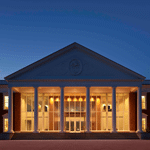In 1992 Duket Architects Planners partnered with Centerbrook Architects on a project for the University of Toledo in Ohio. The project was successful and the partnership amiable, so the two firms decided to join forces again in 2008 for the renovation of a 1970s office building for Health Care REIT, a leading real-estate investment trust in Toledo. According to Michael Duket, principal at Duket Architects, Centerbrook has a great reverence for history, and when necessary, it also has the skills to infuse historic structures with a modern attitude. That’s what happened here. The team outfitted the structure with glass walls to bring in natural light and added a pond to manage storm water. We asked Duket and the firm’s LEED administrator, Gary Ashford, who developed the project’s sustainable strategy, about the specifics of the renovation.

Large fins and louvered wood walls diffuse the light coming in through the building’s south-facing, insulated skylights placed above each atrium. Photo: Feinknopf Photography
You were basically transforming an incredibly outdated structure into a cutting-edge facility. What were some of the challenges you faced during the renovation?
Michael Duket: The schedule was one of the biggest challenges. The owner required occupancy within 18 months from beginning of design through move-in, which was extremely aggressive. We developed a blended design/construction schedule, which allowed demolition and exterior work to begin early. The detailed interior was completed in the last four months. There were many hectic days, but the schedule was met successfully.
In terms of the design, what was the client expecting to see from the project?
Gary Ashford: We were fortunate to work with a sophisticated client who values good design and understands the effect the work environment has on employee performance. They also wanted to create a model for sustainable development, a “living laboratory,” to demonstrate how a corporate sustainability mission can be accomplished in the marketplace.
Duket: Because of the desire for enhanced natural light and views, the manipulation of the façade was an important focus of the design process. Shaping the interior spaces in an inspiring way was also imperative.

An outdoor space with vegetated roof trays was created above the one-story portion of the existing building. The green roof elements, combined with high SRI asphalt shingles and membrane roofing, diminish heat island effect.
How concerned was the client with the natural environment surrounding the project?
Ashford: Prior to being developed into a corporate campus in 1972, it was vacant farmland that was relatively undisturbed from pre-European settlement in the area. Historically, the site is part of the Oak Openings Region, which is a natural habitat for many unique biological species. As a practical measure, the LEED boundary area was defined within the project construction limits, but the owner is managing the entire site as a protected open space resource.
The Health Care REIT headquarters is the first LEED Platinum building in northwest Ohio. Was this the goal from the very beginning or did it happen along the way?
Duket: Health Care REIT owns and manages health-care facilities all over the country, and a commitment to sustainability and energy efficiency is part of its business model. Initially, the intent was to design the building and manage the property to be as energy efficient as possible. Everything on the building interior was removed, so there was an opportunity to provide an energy-efficient building envelope and MEP systems. Once Health Care REIT committed to the LEED process, we were on a quest to achieve as many points as possible to gain certification. Once everyone was truly engaged, the owner accepted the challenge to pursue Platinum certification, so what began as an offhand proposal became the expectation.

The barrel-vaulted great room uses FSC-certified wood throughout, including in the ceiling and the walls, which are a wood veneer panel system with concealed doors, shades, and media equipment. Above, skylights bring natural light deep into the building. Photo: Feinknopf Photography
In what ways does the project demonstrate Duket Architects’ best practices?
Duket: Because of our ability to work as part of a team of dedicated professionals, including the owner’s representatives, CM, and contractors, one gains a remarkable sense of accomplishment working with a group of people from different disciplines creating something great. Everyone had something to contribute.
Ashford: We approach each project considering its physical setting, budget, and client needs—and this was no different. We listen a lot and try to minimize imposing preconceived ideas on a solution.
When you look back at the process from its beginning to its end, what was the most unique aspect of this project?
Duket: The property could have been sold off to a developer and carved into pieces. Instead, Health Care REIT created a very special place for the community that is open for events and special activities. It is truly a community asset.
Ashford: I’m not aware of any other renovation projects that have achieved certification at this level.

